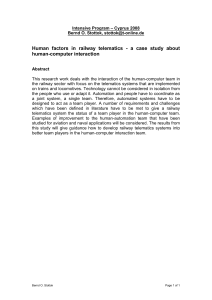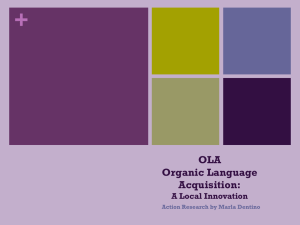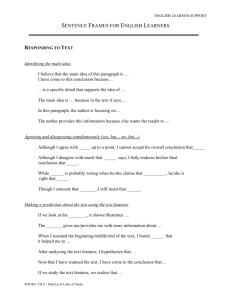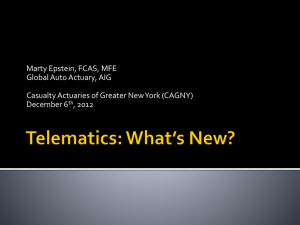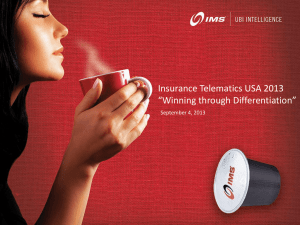Bild 1
advertisement
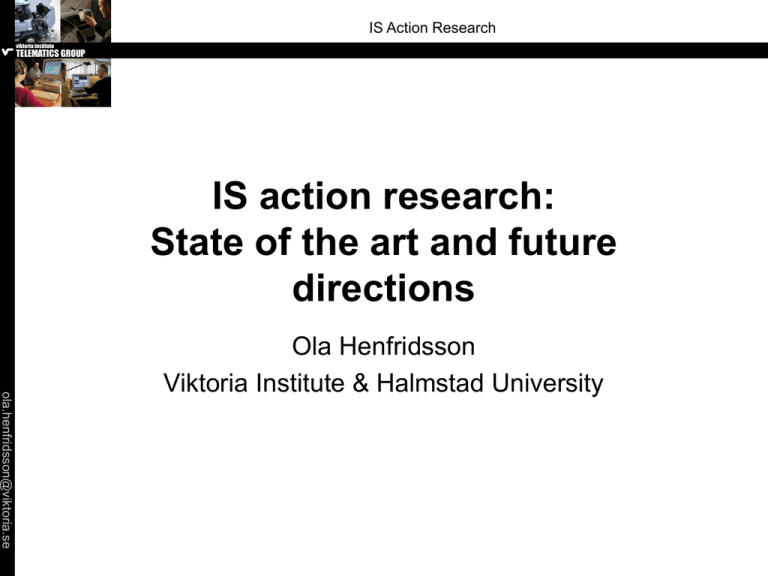
IS Action Research viktoria institute TELEMATICS GROUP IS action research: State of the art and future directions ola.henfridsson@viktoria.se Ola Henfridsson Viktoria Institute & Halmstad University IS Action Research viktoria institute TELEMATICS GROUP Action Research Dual goal: “The action researcher is concerned to create organizational change and simultaneously study the process” (Baskerville and Myers 2004, p. 329-330) Common motivations: Epistemology: pragmatism Relevance to practice Promising methodology, but many different models of action research Action research characteristics (Baskerville and Wood-Harper 1998): ola.henfridsson@viktoria.se Process model (Iterative, reflective, linear) Structure (rigid, fluid) Researcher involvement (collaborative, facilitative, experiment) Primary goals (organizational development, systems design, scientific knowledge, training) IS Action Research viktoria institute TELEMATICS GROUP Types of IS action research (Baskerville & Wood-Harper 1998) ola.henfridsson@viktoria.se IS Action Research viktoria institute TELEMATICS GROUP IS action research Two observations: 1. Few examples of empirical AR studies (with the objective of making a domain-specific (substantive) contribution to, e.g., KM or ERP) Relatively many examples of AR theorizing (new models of, or perspectives on, AR) ola.henfridsson@viktoria.se 2. The IT-artifact has a marginal role in IS action research IT-artifact = “bundles of material and cultural properties packaged in some socially recognized form such as hardware and/or software” (Orlikowski and Iacono 2001) IS Action Research viktoria institute TELEMATICS GROUP Observation #1: Few examples of empirical AR studies (with the objective of making a domain-specific (substantive) contribution) ola.henfridsson@viktoria.se IS Action Research viktoria institute TELEMATICS GROUP Dominance of AR methodology contributions Two lately published special issues: IT & People (2001: Editors: Kock and Lau): 6 articles MIS Quarterly (2004: Editors: Baskerville and Myers): 6 articles Domain-specific (substantive) contributions Davison (2001) Iverson et al. (2004) Kohli and Kettinger (2004) Lindgren, Henfridsson, and Schultze (2004) Street and Meister (2004) Yoong and Gallupe (2001) AR methodology contributions ola.henfridsson@viktoria.se Avison, Baskerville, and Myers (2001) Braa, Monteiro, and Sahay (2004) Chiasson and Dexter (2001) Mårtensson and Lee (2004) McKay & Marshall (2001) Mumford (2001) IS Action Research viktoria institute TELEMATICS GROUP Reflections on the current state Methodological development important However, the value of AR must be evaluated in light of alternative methodologies in terms of its capacity to facilitate substantive research contributions in terms of its promised relevance to practice ola.henfridsson@viktoria.se MISQ special issue important to legitimize AR However, action researchers have still things to prove IS Action Research viktoria institute TELEMATICS GROUP Observation #2: The IT-artifact has a marginal role in IS action research ola.henfridsson@viktoria.se IS Action Research viktoria institute TELEMATICS GROUP Background: the role of the ITartifact in AR IT-artifact: “bundles of material and cultural properties packaged in some socially recognized form such as hardware and/or software” (Orlikowski and Iacono 2001) Less inclusive than Hevner et al (2004): (constructs, instantiations, methods, and models) ola.henfridsson@viktoria.se Role: Part in the researchers’ action Part in developing the research contribution IS Action Research viktoria institute TELEMATICS GROUP ola.henfridsson@viktoria.se IS Action Research viktoria institute TELEMATICS GROUP Reflections on the current state The IT-artifact is part of the researchers’ action in some IS action research (3 out of the 6/12) The IT-artifact is basically never a significant part of the contribution (developing the contribution) This is a problem in IS action research ola.henfridsson@viktoria.se IS Action Research viktoria institute TELEMATICS GROUP Two recent AR projects Design principles for Competence Management Systems [1999-2001] Lindgren, R., Henfridsson, O., and Schultze, U. "Design Principles for Competence Management Systems: A Synthesis of an Action Research Study," MIS Quarterly (28:3) 2004, pp 435-472. Multi-Contextuality in Ubiquitous Computing [2002-2004] ola.henfridsson@viktoria.se Henfridsson, O., and Lindgren, R. "Multi-Contextuality in Ubiquitous Computing: Investigating the Car Case through Action Research," Information and Organization (15:2) 2005, pp 95-124. IS Action Research viktoria institute TELEMATICS GROUP AR Methodology in Use at Viktoria Canonical action research (Davison et al. 2004; Susman & Evered 1978) Prototype-based action Delivering “design principles” for a specific system type grounded in socio-technical theory IT-artifact in focus: without leaving social issues behind? ola.henfridsson@viktoria.se IS Action Research viktoria institute TELEMATICS GROUP Background Modern automobile – success for ubiquitous computing technologies Whole set of computer systems Weaved into the fabric of our everyday life ola.henfridsson@viktoria.se However, the vehicle has been traditionally a closed system Telematics is slowly changing this The connected car Implications for product development, insurance, car maintenance, transportation, IS Action Research viktoria institute TELEMATICS GROUP What is telematics? The integrated use of telecommunications, positioning technologies, and IT Specifically, the use of such systems within road vehicles GM’s OnStar All GM brands (and a few other) sold in the US Subscription model: different service packages Fleet management, infotainment, remote diagnostics, vehicle management, and many more ola.henfridsson@viktoria.se IS Action Research viktoria institute TELEMATICS GROUP Personal telematics Integrated use of mobile devices and embedded computing platforms for providing in-car user services Provides temporary and synchronized networks between vehicles and mobile devices for leveraging the convenience and safety such services Lifecycle differences Competition from aftermarket solution providers ola.henfridsson@viktoria.se IS Action Research viktoria institute TELEMATICS GROUP Multi-contextuality in ubiquitous computing ola.henfridsson@viktoria.se Mobile services are multicontextual Used over different spatiotemporal contexts by people on the move Combining mass-scale with situated support: design challenge Different use requirements in boundary-spanning mobility Minimal assumptions about use contexts for maximizing mobility and personalization (Lyytinen and Yoo 2002) Multi-contextuality: the coexistence of different use contexts IS Action Research viktoria institute TELEMATICS GROUP Multi-Contextuality in the Car Setting ola.henfridsson@viktoria.se The Car Setting Supports spatial/physical mobility Mobile devices used for handling the temporality of social activity (cf. Kakihara and Sørensen 2002) Provides advanced computing and connectivity capabilities What are the socio-technical design implications related to the coexistence of different use contexts in the car? Grounded action research study (Baskerville & Pries-Heje 1999) Saab Automobile, Mecel, and Vodafone Objectives Develop and evaluate design principles for handling multicontextuality surrounding mobile device use in cars Explore socio-technical implications in an authentic setting IS Action Research viktoria institute TELEMATICS GROUP ola.henfridsson@viktoria.se IS Action Research viktoria institute TELEMATICS GROUP Mobile phone use in cars: categories, concepts, and data ola.henfridsson@viktoria.se IS ActionMOBILE Research viktoria institute DEVICE MANIPULATION TELEMATICS GROUP (PHYSICAL) CONTEXT CHANGE ATTENTION-SHIFTING PRE-PARING ola.henfridsson@viktoria.se (WIRED) WORK-AROUNDS IS Action Research viktoria institute TELEMATICS GROUP Design principles The principle of context switching support: Support switches between different physical and social contexts. The principle of contextually adapted manipulation: Provide the user with device or service controls adapted to the spatiotemporal conditions in question. The principle of context-sensitive service synchronization: ola.henfridsson@viktoria.se Make selective services associated with the mobile device available (deemed plausible for the car setting) to users. IS Action Research viktoria institute TELEMATICS GROUP The SeamlessTalk prototype Facilitates driver (or passenger) control of Bluetooth-equipped mobile phones brought into the car Embeds the design principles developed ola.henfridsson@viktoria.se IS Action Research viktoria institute TELEMATICS GROUP ola.henfridsson@viktoria.se IS Action Research viktoria institute TELEMATICS GROUP Evaluation overview ola.henfridsson@viktoria.se IS Action Research viktoria institute TELEMATICS GROUP UbiComp challenges Synchronizing fluid use patterns Differences in individual use patterns make it hard to deliver mass-scale services The openness of mobile devices triggers an abundance of such use patterns Increased number of services provided by multi-purpose devices Scaling service manipulation ola.henfridsson@viktoria.se A UbiComp environment cannot always be assumed to meet the specific requirements of the services hosted Different interaction models, e.g., differences in temporal assumptions Signaling context-switches through awareness support Context-switching can be a source of uncertainty Signaling context-switches can be an appropriate way to place computing in the background, e.g., audio, motion, and visual feedback IS Action Research viktoria institute TELEMATICS GROUP Many thanks for your attention! ola.henfridsson@viktoria.se

